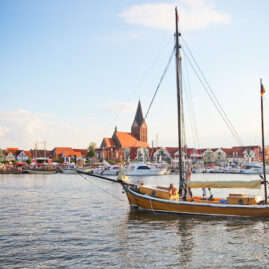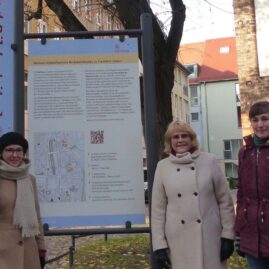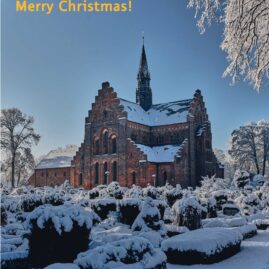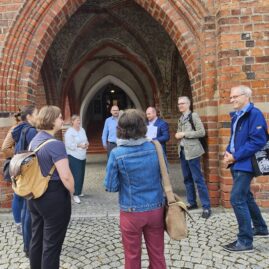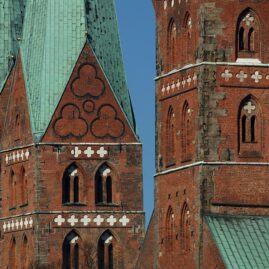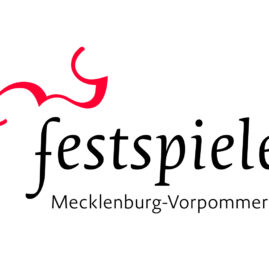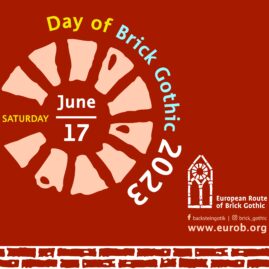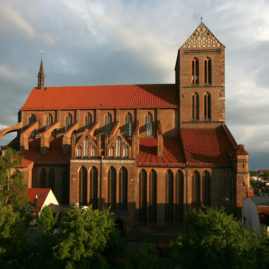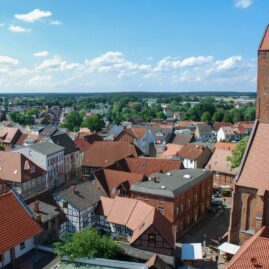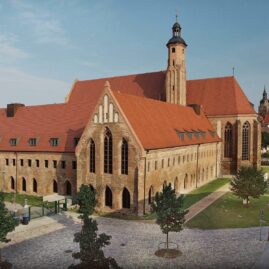St. Mary’s Church in Frankfurt (Oder) ranks among the largest hall churches of Northern German Brick Gothic. For good reason, too, as visitors will perceive the exterior of the church as an imposing brick monument. Upon entering it, however, many visitors are surprised to find themselves in an empty nave. Before the Second World War, things were quite different: rich treasures of art still filled the church. Among its furnishings were a gold-crowned high altar (1489), a 4.70-metre-wide bronze baptismal font, a seven-branched candelabrum (both around 1376) and the stained glass of the three main chancel windows with biblical scenes and the story of the life and death of the Antichrist (around 1360), along with the pews, the pulpit, and the organ. While fire destroyed the latter in April 1945, the altar, the baptismal font and the candelabrum have found a new home with the Protestant congregation in St. Getrude’s Church.
The fact that the valuable chancel windows still exist today is partly due to a decree on air-raid protection of cultural assets issued by the Reich Ministry of Science, Education and Culture in 1940. In late summer 1941, a Frankfurt glazier removed, disassembled and numbered the windows and then packed them in wooden crates. Having been stored for some time in the crypt of a church and in the cellar of a vicarage, the crates were finally taken for protection to the New Palace in Potsdam Sanssouci in 1945. Shortly after the end of the war, Soviet “art protection officers” discovered the Frankfurt stained-glass windows. In mid-August 1946, they left Germany with military special train 176/8042 heading east. Thereafter, their whereabouts remained unknown.
Any investigations by the parish and the Office for Historical Monuments into the whereabouts of the chancel windows were at once thwarted in the GDR era. It was not until 1991, some 45 years later, when information emerged that the window panels still existed in a special depot at the Hermitage, in what is now St. Petersburg. It would take more than ten years of countless negotiations at the highest political level before the Russian parliament agreed to their repatriation on 5 April 2002. This made the Frankfurt stained-glass windows the first works of art ever to be returned by Russia after the law on looted art had come into force. However, this was only possible because they were church property.
Finally, on 29 June 2002, the chancel windows made it to Frankfurt (Oder) aboard a special transporter. With great public participation, representatives of politics and the media welcomed the 22 boxes in front of St. Mary’s Church. Six missing panes were found three years later in the Pushkin Museum in Moscow and then returned in 2008.
During the next seven years, the 117 coloured panes, each 47 centimetres wide and 84 centimetres high, were painstakingly restored and reinstalled. To this end, the chancel – destroyed during the war – was restored and given back its medieval colour scheme. A modern design by Hans Burger was the basis for the redesign of the seven neighbouring windows to create an adequate surrounding for the three main windows. Today, the stained-glass treasure of St. Mary’s is one of the city’s main attractions.
So, what is it that makes these stained-glass windows so special? Comparable sets of medieval stained glass are extremely rare, and scholars regard the Antichrist Window to be unique.
Six hundred years ago, churchgoers were mostly illiterate. The colourful stained-glass windows served as an illustrated version of the Bible for these medieval visitors: the left window of the three main chancel windows (the Genesis window) shows scenes from the Old Testament’s Cycle of Creation. The middle section of the central window (the Christ window) depicts the life of Jesus. The window on the right deals with the life and death of the Antichrist. In line with medieval beliefs, the radiant stained glass was also a symbol of the crystal city of God – the “heavenly Jerusalem” mentioned in the New Testament’s Book of Revelation.
Upon closer scrutiny, several window panels turn out to be special: the Genesis window cycle, for example, includes rare extra-biblical motifs such as the clothing of Adam and Eve after the Fall. There are also fragments from windows of St. Mary’s Church that no longer exist: they stand out for their different proportions.
Scholars have focused primarily on the window of the Antichrist. According to tradition, the false Messiah appears on earth in the shape of a human as a harbinger of the approaching end of the world. With lies and false miracles, the Antichrist tries to dissuade people from true faith and to take over the rule of the world. He can be recognised visually by the letter T on his forehead, a symbol that also his followers bear.
The motifs “Jews Waiting by the River” and “Antichrist with the Jews by the River” are puzzling. Here, some Jews are depicted red or reddish and can be associated with the folk legend of the “red Jews”. According to this German language legend, the “red Jews” are an imaginary people who will be servants to the Antichrist when the end of times is imminent. Note, however, that the Jews on these two panels do not bear the “T” symbol that marks the followers of the Antichrist.
The chancel windows were created in a time of plague epidemics, bad harvests and political and ecclesiastical power struggles. It is hardly surprising that the Antichrist window should reflect the fear of the end of the world as well as the piety of the people seeking support during the crisis-ridden 14th century.
The circumstances and motifs of the chancel windows have not lost any of their topicality. In times of the Corona pandemic, talk of the end of the world is once again haunting many people’s minds and spooks the social networks. The splendour of this “Poor Man’s Bible” sends a comforting message in this regard: Frankfurt an der Oder has weathered other crises and rose to become a wealthy Hanseatic city in its time. Whether in gratitude or as a sign of prosperity, during these decades influential merchant families financed major work on their city church as well as the creation of these magnificent stained-glass windows.
And not even the Antichrist succeeds in usurping the rule of the world, as the Frankfurt chancel window shows: Saint Michael the Archangel vanquishes the false Messiah in the end on the Mount of Olives and slays him with a great sword.
By Henriette Brendler, Kulturbüro Frankfurt (Oder)
Information on the images shown:
Three individual motifs from the Frankfurt stained-glass windows: the condemnation of Adam and Eve (left, Genesis window), the Antichrist preaching in the temple (centre) and Jews waiting by the river (right, both from the Antichrist window).
Further reading:
– Kulturbüro Frankfurt (Oder) [eds.]: Frankfurter Bilderbibel. Die Glasmalereien von St. Marien. Verlag Schnell & Steiner. Regensburg 2022.
– Gow, Andrew Colin: Das Gefolge des Antichristen: Zur Legende von den „roten Juden“. In: Knefelkamp, Ulrich/Martin, Frank [eds.]: Der Antichrist. Die Glasmalereien der Marienkirche in Frankfurt (Oder). Edition Leipzig. Leipzig 2008, S. 102–112.








